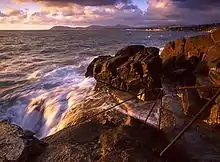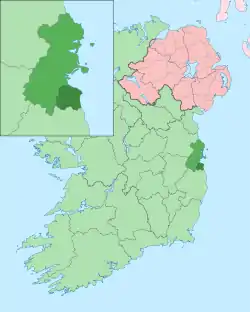Killiney
Killiney (Irish: Cill Iníon Léinín, meaning "Church of the Daughters of Léinín") is an affluent seaside resort and suburb in Dún Laoghaire–Rathdown, Ireland. It lies south of neighbouring Dalkey, and north of Shankill. The place grew around the 11th century Killiney Church, and became a popular seaside resort in the 19th century. It is part of the Dáil Éireann constituency of Dún Laoghaire.
Killiney
Cill Iníon Léinín | |
|---|---|
Suburb of Dublin | |
 Killiney Bay | |
 Killiney Location in Ireland | |
| Coordinates: 53.2651°N 6.1137°W | |
| Country | Ireland |
| Province | Leinster |
| County | Dún Laoghaire–Rathdown |
| Elevation | 30 m (100 ft) |
| Population (2002) | |
| • Urban | 10,600 |
| Eircode (Routing Key) | A96 |
| Area code(s) | 01 (+3531) |
| Irish Grid Reference | O240261 |
Amenities
Killiney Hill Park was opened in 1887 as Victoria Hill, in honour of Queen Victoria's 50 years on the British throne. The park has views of Dublin Bay, Killiney Bay, Bray Head and the mountain of Great Sugar Loaf (506 m), stretching from the Wicklow Mountains right across to Howth Head. The Park's topography is steep, and its highest point, at the obelisk, is 170 metres above sea level.
Other attractions include Killiney Beach, Killiney Golf Club, a local Martello Tower, and the ruins of Cill Iníon Léinín, the church around which the original village was based.
The coastal areas of Killiney are often compared to the Bay of Naples in Italy. This comparison is reflected in the names of surrounding roads, like Vico, Sorrento, Monte Alverno, San Elmo and Capri. On clear days, the Mourne Mountains of County Down can be seen. Killiney Hill Park was once part of the estate of Killiney Castle, now a hotel. Since early 2010, a pod of bottlenose dolphins has been seen occasionally in Killiney Bay.
History
The village of Killiney takes its name from the site of the Nuns' Abbey. Leinin, a local chieftain, and his seven daughters converted to Christianity, and together they went on to found a monastic community on Marino Avenue West. Today the family are commemorated in the stained glass windows of the Church of St Alphonsus and Columba in Ballybrack, just a couple of minutes' walk away. Although the establishment of the first church dates back to the sixth century, its current roofless ruin dates from the 11th century. This tiny chapel on Marino Avenue West marks the historical centre of Killiney village, and can still be viewed today.
For many centuries the major part of the district was the property of the Talbot de Malahide family, some of the original followers of the 1170 Norman invasion. The obelisk on top of Killiney Hill records the famine of 1741 and the relief works made for the poor which include the obelisk and the many walls which cover the top of the hill. By the 19th century, the areas to the north and east of the village were owned by Robert Warren, who developed many of the Victorian residential roads. The Warrens also sold the land required to extend the Dublin and Kingstown Railway to Killiney and ultimately Bray. Killiney beach was a popular seaside destination for Dubliners, and John Rocque's 1757 map shows bath-houses near White Rock, on Killiney Beach. The coastline became even more popular once the railway opened, and the opening of Victoria Park in 1887 and the opening of Vico Road in 1889 appear to have increased this popularity further. Victoria Castle (later renamed Manderley Castle) was also built in honour of Queen Victoria, specifically of her accession to the throne. This is currently owned by County Donegal-born singer Enya.
Killiney remained a near-rural area from 1900 until the late 1940s, despite its proximity to Dublin city. From the early 1960s, the economy began to expand, and thus Dublin's reach into areas in its hinterland like Killiney.
20th-century development

In the first half of the 20th century, the Electoral Division of North Killiney still consisted of a small village at its centre and a number of suburban roads lined with large houses. A few modest cottages were occupied by working-class locals and bohemian residents such as George Bernard Shaw, whose house, Torca Cottage, is close to the boundary with Dalkey.
South Killiney consisted of farmland, uncultivated hillside and woodland, a few large country houses (Ballinclea House, in particular, owned by the Talbot de Malahide family[1] and destroyed by fire in the early 1970s, and Rochestown House, near to the contemporary Killiney Shopping Centre), the convent of the Sisters of St. Joseph of Cluny and Killiney Golf Club, a nine-hole course founded in 1903.
Killiney's population grew substantially in the decades following the Emergency as the urbanisation of Ireland and the suburbanisation of Dublin progressed. The main sub-districts most locals will identify are Killiney Hill Park, Roche's Hill (locally called Mullins' Hill), Killiney village itself, North Killiney (Cluny Grove, Killiney Road, Ballinclea), Killiney Hill Road and Vico Road. The last six of these areas are developed, most frequently with two-storey housing, at average densities of 10 to 30 houses per hectare. North Killiney mainly consists of two-bedroom, two-storey housing at 10 to 30 houses per hectare.
The population, as recorded by the Census of Ireland, peaked in 1996 at approximately 10,800 and has fallen by about 12% since then, as falling average family sizes have outpaced residential construction.
Transport
Bus
The area is served by the 59 bus route operated by Go-Ahead Ireland which runs hourly from Killiney Village to Marine Road, Dún Laoghaire. The journey takes 25 minutes.
An Aircoach service starting at Fitzpatrick's Castle Hotel links Killiney with Dublin Airport every hour, 24 hours a day.
Rail
Killiney railway station, served by the DART, is located on Station Road.[2]
Notable people
Killiney is one of Dublin's most exclusive residential areas. Its notable residents include U2 members Bono and the Edge. Former racing driver Eddie Irvine is also occasionally seen in Killiney. Actor Allen Leech was born in Killiney, as was radio presenter Paddy O'Byrne. Singer Enya lives in Manderley Castle in Killiney. Renowned gardener Alice Lawrenson lived in Killiney in the 1800s.
The 1960s rock band Mellow Candle, originated in Killiney, formed by students from the Holy Child Convent. Influential musician Kevin Shields, of My Bloody Valentine, lived in Killiney for part of his youth.
Sources
- The History of Killiney Hill Park Dunlaoghaire-Rathdown County Council
- Carrickmines Castle, the Vale of Shanganagh, Dalkey, Killiney and Ballybrack Hills (Waybackmachine archive link)
- Pearson, Peter (1998). Between the Mountains and the Sea: Dún Laoghaire–Rathdown County, Dublin: The O'Brien Press. ISBN 0-86278-582-0.
References
- "Who is who in Dublin". Admiralty and Horse Guards Gazette, 1901. https://books.google.com/books?id=p5QNAAAAYAAJ&pg=PA214&lpg=PA214&dq=%22ballinclea+house%22+killiney&source=bl&ots=A6nuKVk4kV&sig=ghiJ2b5ORmtZAdyVE87vqUzYx1E&hl=en&sa=X&ei=T5AOUr7zDpKp4APYi4CoCA&ved=0CEUQ6AEwBA#v=onepage&q=%22ballinclea%20house%22%20killiney&f=false
- "Irish Rail Killiney Station". Irish Rail. Retrieved 2007-08-31.
External links
| Wikimedia Commons has media related to Killiney. |
